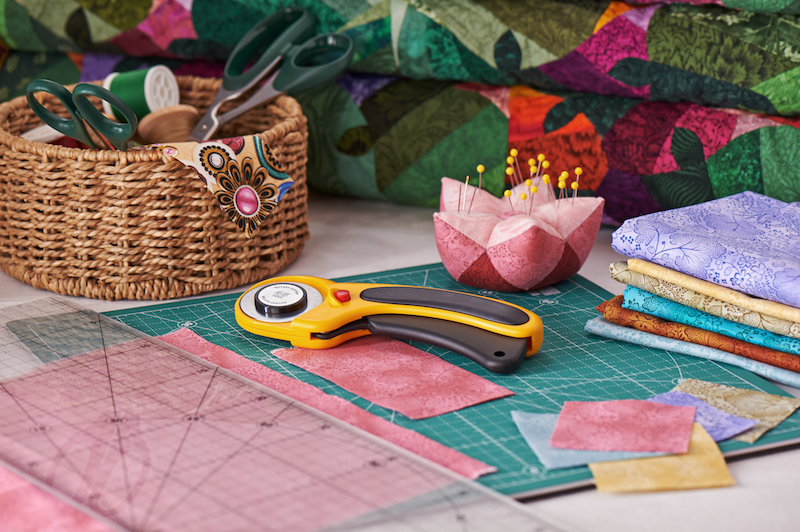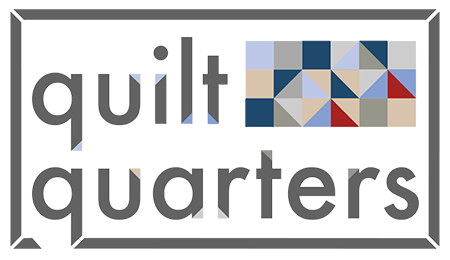 Getting started on quilting can be an overwhelming undertaking but, once you get started, quilting becomes a fabulous craft that allows you to create gorgeous pieces of art that are functional as decorations, bed covers, and make great gifts. So, how do you get started in the world of quilting? There are a few steps you can take to make your journey into the crafting world of quilting an easy one. The best thing to do is learn basic quilting practices that you can carry with you and repeat each time that you start a new quilting project.
Getting started on quilting can be an overwhelming undertaking but, once you get started, quilting becomes a fabulous craft that allows you to create gorgeous pieces of art that are functional as decorations, bed covers, and make great gifts. So, how do you get started in the world of quilting? There are a few steps you can take to make your journey into the crafting world of quilting an easy one. The best thing to do is learn basic quilting practices that you can carry with you and repeat each time that you start a new quilting project.
Ten Basic Quilting Practices for Beginners
1. Find A Work Area With As Much Surface Space As Possible
When it comes to quilting, you’re guaranteed to be working with a lot of fabric. And a lot of fabric tends to get heavy. The best options for quilting tables are going to include a table top that offers a lot of surface area and has a drop-in feature so that the quilting needle is level with the table top. This will ensure that your quilt stays level with the needle as it stitches and gravity does not cause your stitching to pull or drag. Don’t have the funds for a new quilting table? No worries! Set up your machine on a central table then use additional tables set up around your central workstation to give yourself more surface area.
2. Choose Matching Thread Colors for Top and Bobbin
Choosing thread prior to starting your quilting project is as important as choosing your fabric and your quilting pattern. Be sure to choose threads that match in color for your top thread and your bobbin. Unless your threading technique is absolutely perfect, you’re likely to have bobbin thread showing on the top of the quilt and top thread appearing through the back of it. The best way to avoid this from occurring is to use thread for both your top and bobbin thread that match in color.
3. Practice Techniques on Scrap Fabrics
It can be tempting to dive right into your first quilting project and start with a full-sized quilt. But it’s better, in the long run, to practice your various quilting techniques on scrap fabrics. That doesn’t just apply to stitching techniques either. You’ll want to practice cutting and piecing your quilt, as well. One of the best ways to start is to cut two scraps of fabric 10 inches or larger and layer batting between them. These samples will allow you to play around with various combinations of thread as well as batting types and will allow you to check your tension while stitching out different designs to see what you like and how they look! You can also keep your samples to use as reference pieces throughout your quilting journey!
4. Start with Simple Designs and Work Your Way Up
There are so many gorgeous quilting designs out there and down the road you’ll be making intricate quilting designs but it’s the best quilting practice to start with simple designs and work your way up. Your first quilt is likely to be made up of large squares, strip piecing, or even pre-cut quilting pieces. Whether you’re using a straight walking foot or a free-motion quilting foot, you can achieve gorgeous quilts while using simple pieces to start.
5. Develop a Plan Before Starting Your Quilting Project
It can be tempting to jump right into your quilting project but it’s better to develop a plan before you get started. This may mean you’re photographing your pieces as you create them to visually stitch them together or you’re using a quilting design software to create a design before getting started, it’s best to have a plan before you get behind your machine.
6. Cover Up Mistakes with Fabrics Featuring Busy Prints
Mistakes are bound to happen, it’s your first of many quilts! And mistakes can be covered up with fabrics featuring busy prints or by blending threads together. Whatever your technique, when a mistake happens, do not feel like you have to throw away all of your progress. One of the best things about quilting is the creativity that it requires and that includes the creativity it requires to overcome mistakes.
7. Complete Your Quilt From Start to Finish Yourself
It may seem unbelievable but there are plenty of people out there who will plan and piece their quilt then outsource the stitching! And that’s fine but if you are wanting to create a quilt of your own then it’s important to complete your quilting project from start to finish yourself. When you commit to quilting your own quilt from the first cut to the last stitch you allow yourself the time to practice as much as possible. And as cliche as it sounds, practice makes perfect, especially in the world of quilting!
8. Add Intricate Patterns to Your Background
While it may seem odd to hear the word “intricate” when talking about basic quilting practices for beginners, adding patterns to your quilt’s background is one way to add intricacy to your quilt without requiring too much skill. There are two key elements to beautiful background texture: asymmetry and variety. Washable markers and stencils are going to be your best friend in this instance along with confidence that your background pattern will compliment your quilt no matter what.
9. Educate Yourself Before You Get Started
While quilting may seem as easy as cutting, piecing, and stitching, there’s a lot that goes into completing your first quilt! It’s best practice to educate yourself as much as you can on quilting before you get started on your first project. This could mean reading books about quilting or attending an online class. At Quilt Quarters, there are a variety of quilting classes available each month, for beginner and veteran quilters alike, including open sew studios where experienced and inexperienced quilters alike can gather to work on projects.
10. Stay Positive Throughout Your Project
Quilting isn’t a natural born skill and every quilter out there has had to work hard to improve their skill. Just as you learn to do anything, two things are important when it comes to starting your quilting career: practice and positivity. No matter what road blocks you run into throughout your quilting project, stay positive. Remember that any stitch can be unstitched and any piece can be replaced. Your quilt isn’t finished until you say it is and each completed quilt is a work of art.
At Quilt Quarters, we have everything a quilter needs to get started on their first or their fiftieth quilt. Stop into our store at 9504 Haver Way Road in Indianapolis, Indiana or shop our selection of fabric, thread, batting, notions, and more online. Are you such a beginner that you don’t even have a quilting machine? Welcome to the quilting club! Call us at (317) 757-8340 and speak to a member of our team or schedule a time to stop in and see what machines we have available in-store.
